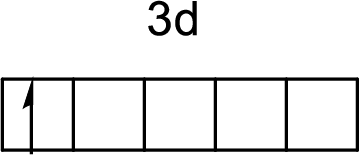
Assign a correct set of four quantum numbers for
- (a) Each electron in a nitrogen atom.
- (b) The valence electron in a sodium atom.
- (c) A 3d electron in a nickel atom.
(a)
Interpretation:
A correct set of four quantum numbers for each electron in nitrogen atom has to be given.
Concept Introduction:
Principal Quantum Number (n): In an atom, the electron energy mainly depends on principal quantum number. The energy of an electron becomes lower when the value of n is smaller. The orbital size also depends on n. The size of orbital increases with increase in value of principal quantum number (n)
Angular Momentum Quantum Number (l): It helps to differentiate different shapes of orbitals for given n. For a given n, there are n different shapes of orbitals are present and are denoted as l. Angular momentum quantum number is also known as Azimuthal quantum number. The possible values of angular momentum quantum number are between
Magnetic Quantum Number (
Spin Quantum Number (
Explanation of Solution
The electronic configuration of nitrogen atom is given by
The arrangement of electrons in nitrogen atom is

First electron in 1s orbital:
Second electron in 2s orbital:
First electron in 2s orbital:
Second electron in 2s orbital:
First electron in 2p orbital:
Second electron in 2p orbital:
Third electron in 2p orbital:
(b)
Interpretation:
A correct set of four quantum numbers for valence
Concept Introduction:
Refer to part (a)
Explanation of Solution
The electronic configuration of sodium atom is given by
The arrangement of valence

First electron in
(c)
Interpretation:
A correct set of four quantum numbers for a
Concept Introduction:
Refer to part (a)
Explanation of Solution
The electronic configuration of nickel atom is given by
The arrangement of a

First electron in
Want to see more full solutions like this?
Chapter 5 Solutions
Chemistry: The Molecular Science
- The cesium atom has the lowest ionization energy, 375.7kJmol1 , of all the neutral atoms in the periodic table. What is the longest wavelength of light that could ionize a cesium atom? In which region of the electromagnetic spectrum does this light fall?arrow_forwardWhat experimental evidence supports the quantum theory of light? Explain the wave-particle duality of all matter .. For what size particles must one consider both the wave and the particle properties?arrow_forwardWhat is the maximum number of electrons that can occupy a f subshell (l = 3)?arrow_forward
- Potassium atoms in a flame emit light as they undergo transitions from one energy level to another that is 4.91019J lower in energy. Calculate the wavelength of light emitted and, by referring to Figure 4.3, predict the color visible in the flame.arrow_forward6.96 When a helium atom absorbs light at 58.44 nm, an electron is promoted from the 1s orbital to a 2p orbital. Given that the ionization energy of (ground state) helium is 2372 kJ/ mol, find the longest wavelength of light that could eject an electron from the excited state helium atom.arrow_forwardA bright violet line occurs at 435.8 nm in the emission spectrum of mercury vapor. What amount of energy, in joules, must be released by an electron in a mercury atom to produce a photon of this light?arrow_forward
- Use the mathematical expression for the 2pz wave function of a one-electron atom (see Table 5.2) to show that the probability of finding an electron in that orbital anywhere in the x-y plane is 0. What are the nodal planes for a dxz orbital and for a dx2y2 orbital?arrow_forwardWhat type of electron orbital (i.e., s, p, d, or f) is designated by an electron with quantum numbers (a) n=1,l=0,m l =0(b) n=3,l=2,m l =1? (c) n=4,l=3,m l =3arrow_forwardThe energy needed to ionize an atom of element X when it is in its most stable state is 500kJmol1 . However, if an atom of X is in its lowest excited state, only 120kJmol1 is needed to ionize it. What is the wavelength of the radiation emitted when an atom of X undergoes a transition from the lowest excited state to the ground state?arrow_forward
- Which of the following sets of quantum numbers correctly represents a 4p orbital? (a) n = 4, = 0, m = 1 (b) n = 4, = 1, m = 0 (c) n = 4, = 2, m = 1 (d) n = 4, = 1, m =2arrow_forwardWhat are quantum numbers? What information do we get from the quantum numbers n, l, and ml? We define a spin quantum number (ms), but do we know that an electron literally spins?arrow_forward
 Chemistry: Principles and PracticeChemistryISBN:9780534420123Author:Daniel L. Reger, Scott R. Goode, David W. Ball, Edward MercerPublisher:Cengage Learning
Chemistry: Principles and PracticeChemistryISBN:9780534420123Author:Daniel L. Reger, Scott R. Goode, David W. Ball, Edward MercerPublisher:Cengage Learning Chemistry: Principles and ReactionsChemistryISBN:9781305079373Author:William L. Masterton, Cecile N. HurleyPublisher:Cengage Learning
Chemistry: Principles and ReactionsChemistryISBN:9781305079373Author:William L. Masterton, Cecile N. HurleyPublisher:Cengage Learning Chemistry: The Molecular ScienceChemistryISBN:9781285199047Author:John W. Moore, Conrad L. StanitskiPublisher:Cengage Learning
Chemistry: The Molecular ScienceChemistryISBN:9781285199047Author:John W. Moore, Conrad L. StanitskiPublisher:Cengage Learning Chemistry & Chemical ReactivityChemistryISBN:9781133949640Author:John C. Kotz, Paul M. Treichel, John Townsend, David TreichelPublisher:Cengage Learning
Chemistry & Chemical ReactivityChemistryISBN:9781133949640Author:John C. Kotz, Paul M. Treichel, John Townsend, David TreichelPublisher:Cengage Learning Introductory Chemistry: A FoundationChemistryISBN:9781337399425Author:Steven S. Zumdahl, Donald J. DeCostePublisher:Cengage Learning
Introductory Chemistry: A FoundationChemistryISBN:9781337399425Author:Steven S. Zumdahl, Donald J. DeCostePublisher:Cengage Learning Principles of Modern ChemistryChemistryISBN:9781305079113Author:David W. Oxtoby, H. Pat Gillis, Laurie J. ButlerPublisher:Cengage Learning
Principles of Modern ChemistryChemistryISBN:9781305079113Author:David W. Oxtoby, H. Pat Gillis, Laurie J. ButlerPublisher:Cengage Learning





